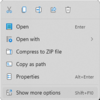Pretty much every one is coming back with some flavor of this error during install when it attempts to start the SQL Server
Cannot use file 'C:\Program Files\Microsoft SQL Server\MSSQL11.SQLEXPRESS\MSSQL\Template Data\master.mdf' because it was originally formatted with sector size 4096 and is now on a volume with sector size 32768. Move the file to a volume with a sector size that is the same as or smaller than the original sector size.
fsutil reports this
C:\windows\system32>fsutil fsinfo sectorinfo c:
LogicalBytesPerSector : 512
PhysicalBytesPerSectorForAtomicity : 32768
PhysicalBytesPerSectorForPerformance : 32768
FileSystemEffectivePhysicalBytesPerSectorForAtomicity : 4096
Device Alignment : Aligned (0x000)
Partition alignment on device : Aligned (0x000)
No Seek Penalty
Trim Supported
Not DAX capable
Not Thinly-Provisioned
So.. I think.. I'm on the right path of what my problem is here.. It's just.. What can I do about it? it's like writing is happening at 4096 and reading at 32768 which is confusing the hell out of SQL.
There's.. Precious little info about this. Most are regarding people trying to RESTORE a database that was done on another disk with a different sector size. Which is not the problem here.
The only real info I found on it was one report where Dell was issuing a BIOS update to resolve, but, it actually wound up being a 'bad' drive.. See this LocalDB Cannot Start, Strange Error in Log contains "sector size 4096 and is now on a volume with sector size 3072"
That was way back in 2013.. I feel this has something to do with the drive itself, and likely a firmware update needed for the drive. It's a Samsung NVMe 991.. Very new, and I can't find firmware for it at all to try an update. The PC is an HP and there's no BIOS updates for it.
I doubt this is a windows 11 issue, but.. Hey.. It is on win 11. Figure I'd throw it out here and see if anyone had any thoughts different than what I do. I have a feeling i'll probably wind up in some kind of logical hell between Samsung and HP where they pass the buck between each other and then attempt to kick it back to microsoft. I really don't think this is a windows or SQL issue.
Cannot use file 'C:\Program Files\Microsoft SQL Server\MSSQL11.SQLEXPRESS\MSSQL\Template Data\master.mdf' because it was originally formatted with sector size 4096 and is now on a volume with sector size 32768. Move the file to a volume with a sector size that is the same as or smaller than the original sector size.
fsutil reports this
C:\windows\system32>fsutil fsinfo sectorinfo c:
LogicalBytesPerSector : 512
PhysicalBytesPerSectorForAtomicity : 32768
PhysicalBytesPerSectorForPerformance : 32768
FileSystemEffectivePhysicalBytesPerSectorForAtomicity : 4096
Device Alignment : Aligned (0x000)
Partition alignment on device : Aligned (0x000)
No Seek Penalty
Trim Supported
Not DAX capable
Not Thinly-Provisioned
So.. I think.. I'm on the right path of what my problem is here.. It's just.. What can I do about it? it's like writing is happening at 4096 and reading at 32768 which is confusing the hell out of SQL.
There's.. Precious little info about this. Most are regarding people trying to RESTORE a database that was done on another disk with a different sector size. Which is not the problem here.
The only real info I found on it was one report where Dell was issuing a BIOS update to resolve, but, it actually wound up being a 'bad' drive.. See this LocalDB Cannot Start, Strange Error in Log contains "sector size 4096 and is now on a volume with sector size 3072"
That was way back in 2013.. I feel this has something to do with the drive itself, and likely a firmware update needed for the drive. It's a Samsung NVMe 991.. Very new, and I can't find firmware for it at all to try an update. The PC is an HP and there's no BIOS updates for it.
I doubt this is a windows 11 issue, but.. Hey.. It is on win 11. Figure I'd throw it out here and see if anyone had any thoughts different than what I do. I have a feeling i'll probably wind up in some kind of logical hell between Samsung and HP where they pass the buck between each other and then attempt to kick it back to microsoft. I really don't think this is a windows or SQL issue.
- Windows Build/Version
- 11
My Computer
System One
-
- OS
- Win11

















